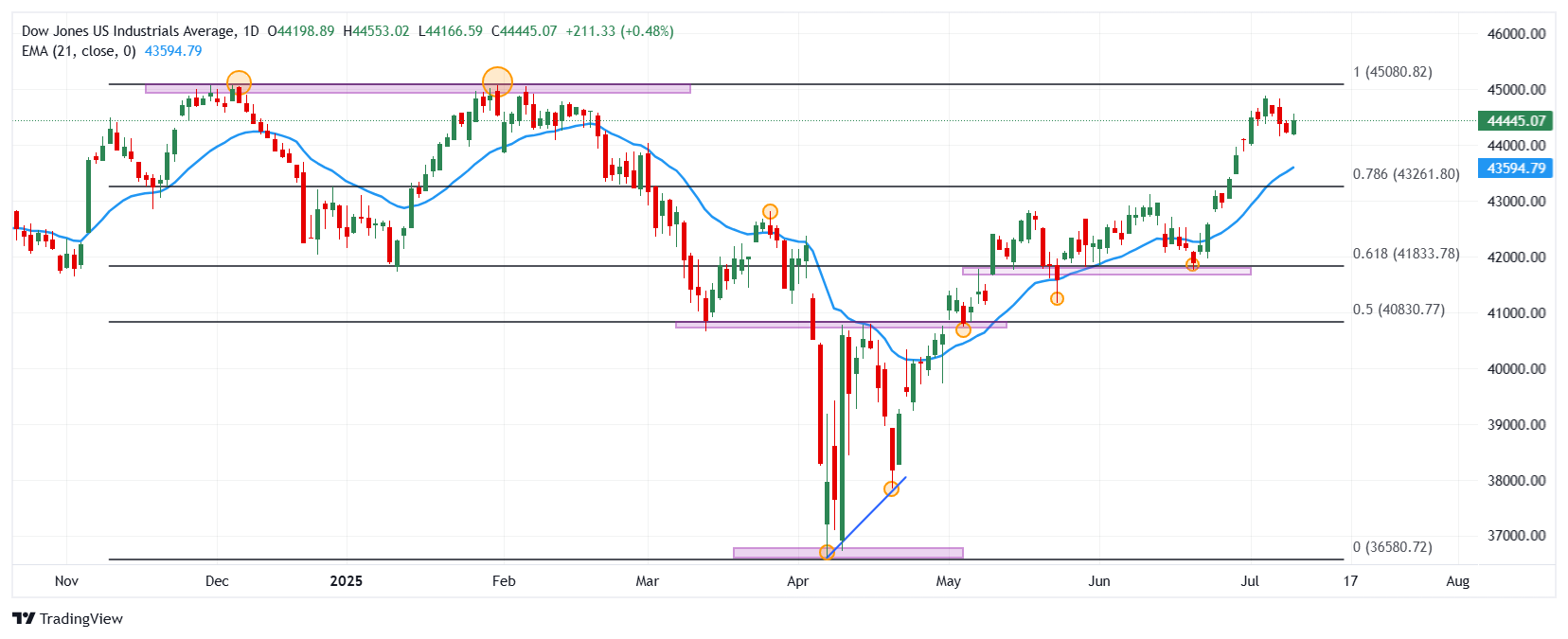- The Dow Jones advances 0.48% daily, reaching maximums of July 7 in 44,553.
- The Nasdaq 100 rises 0.71% in the day, establishing a new historical maximum in 22,914.
- The S&P 500 wins 0.58% today, driven by AES Corporation (AES) and PTC Inc. (PTC).
- Fed minutes showed that the risks of higher inflation remained high.
- Donald Trump warned about new tariffs on all imports from Libya, Iraq, Algeria, Moldova, Brunéi and the Philippines.
The Dow Jones marked a minimum of the day in 44,166, where buyers attracted that promoted the maximum index of July 7 in 44,553.
The Dow Jones industrial average opened at 44,198, while the Nasdaq 100 technological index began operating at 22,678. The S&P 500 began negotiations in 6,219, ending with three consecutive sessions down.
Boeing Company and Merck & Company keep Dow Jones in a profit zone
The Dow Jones index rises 0.48% on Wednesday, operating at the time of writing at 44,445.
Boeing Company (BA) actions advance 3.70% visiting maximums of January 10 in 230.20 $, leading profits in the share index.
In the same tonic the titles of Merck & Company (MRK) rebound a 2.88%, reaching May 2 in 84.48 $, signing its second consecutive day with losses.
The Dow Jones wins 211pantos, ending with three consecutive days down.
Strategy and Vertex Pharmaceuticals drive Nasdaq 100 to new historical maximums
The Nasdaq 100 technological index has a 0.71% gain on Wednesday, establishing a new historical maximum in 22,914.
Strategy titles (MSTR) advance 4.65% daily, visiting maximums not seen since May 22 in 416.34 $, spinning two consecutive sessions with profits.
Following the upward perspective, the shares of VERTEX Pharmaceuticals (VRTX) rebound 2.70% today, exceeding maximum of May 6 in 479.34 $, extending the profits obtained in the previous day.
The Nasdaq 100 goes up 161 points, operating time to write at 22,855.
The S&P 500 reaches maximum of three days supported by AES Corporation and PTC Inc.
Donald Trump announced that from August 1 he will impose tariffs to Libya, Iraq, Algeria, Moldova, Brunéi and the Philippines if satisfactory trade agreements are not delivered.
In another front, the Federal Reserve minutes considered that the majority of the participants of the June 17-18 meeting indicate as appropriate a reduction in the interest rate for this year.
The AES Corporation (AES) values shoot 19.78% in the day, reaching maximums not seen from January 6 to 13.34%, leading profits in the share index.
PTC Inc. titles (PTC) advance 17.65% daily, registering a new historical maximum 213.14 $, signing its second consecutive day with profits.
The S&P 500 goes up 35 points on Wednesday, contributing currently at 6,259.
Technical Analysis of Dow Jones
The Dow Jones established a short -term support given by the minimum of June 19 in 41,971. The following key support is observed in 40,747, a pivot point of May 6, in convergence with the 50% fibonacci setback. To the north, the important resistance is 45,068, maximum of January 31.
Dow Jones daily graphics

Dow Jones – Frequently Questions
The Dow Jones Industrial Avenge, one of the oldest stock market indexes in the world, consists of the 30 most negotiated values in the United States. The index is weighted by the price instead of capitalization. It is calculated by adding the prices of the values that compose it and dividing them by a factor, currently 0.152. The index was founded by Charles Dow, also founder of the Wall Street Journal. In recent years it has been criticized for not being sufficiently representative, since it only follows 30 companies, unlike broader rates such as S&P 500.
There are many factors that promote the Dow Jones Industrial Average (DJIA) index. The main one is the added performance of the companies that compose it, revealed in the quarterly reports of business benefits. The American and world macroeconomic data also contribute, since they influence investor confidence. The level of interest rates, set by the Federal Reserve (FED), also influences the DJia, since it affects the cost of credit, on which many companies depend largely. Therefore, inflation can be a determining factor, as well as other parameters that influence the decisions of the Federal Reserve.
Dow’s theory is a method to identify the main trend of the stock market developed by Charles Dow. A key step is to compare the direction of the Dow Jones Industrial Avenge (DJIA) and the Dow Jones Transportation Average (DJTA) and just follow the trends in which both move in the same direction. The volume is a confirmation criterion. The theory uses elements of maximum and minimum analysis. Dow’s theory raises three phases of the trend: accumulation, when intelligent money begins to buy or sell; Public participation, when the general public joins the trend; and distribution, when intelligent money abandons the trend.
There are several ways to operate with the DJ. One of them is to use ETF that allow investors to negotiate the DJ as a single value, instead of having to buy shares of the 30 companies that compose it. An outstanding example is the SPDR Dow Jones Industrial Avenge ETF (day). Future contracts on the DJ allow the specular operators about the future value of the index and the options provide the right, but not the obligation, to buy or sell the index at a predetermined price in the future. Investment funds allow investors to buy a part of a diversified portfolio of DJ values, which provides exposure to global index.
Source: Fx Street
I am Joshua Winder, a senior-level journalist and editor at World Stock Market. I specialize in covering news related to the stock market and economic trends. With more than 8 years of experience in this field, I have become an expert in financial reporting.







